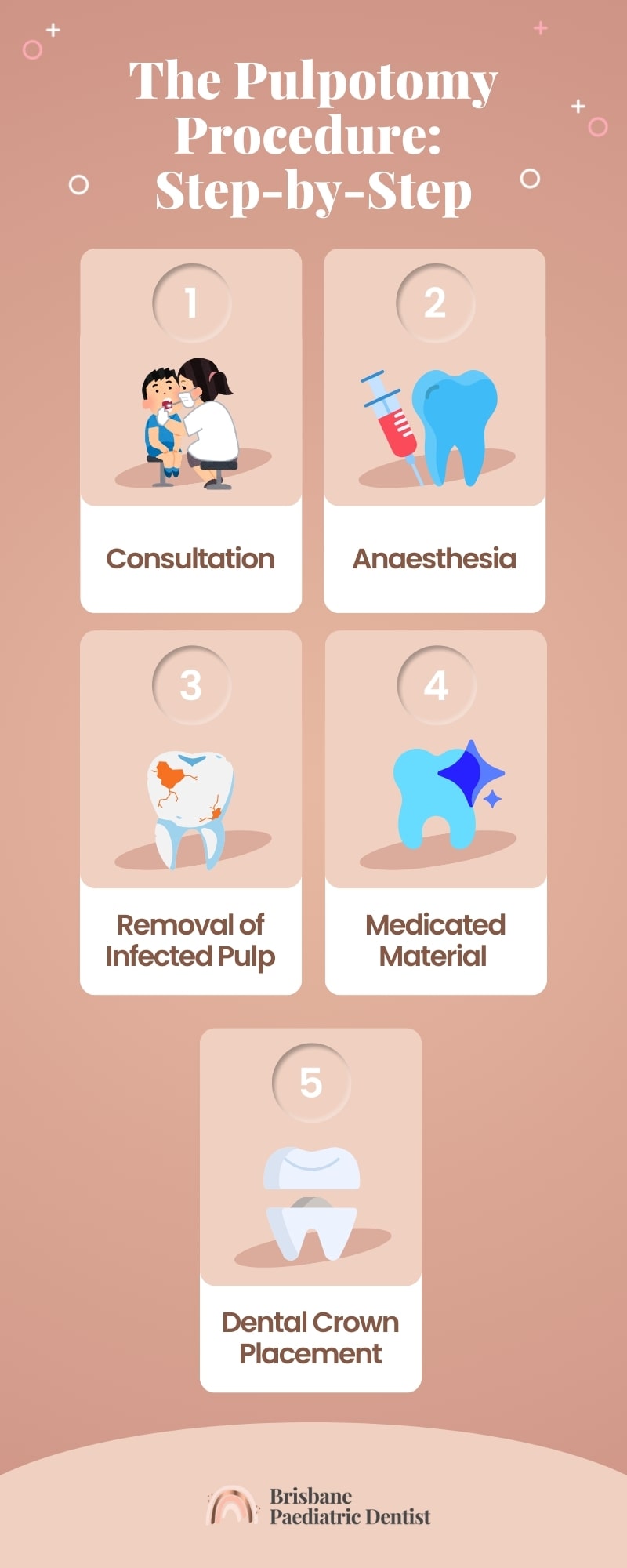Is your child experiencing tooth pain or sensitivity? They may need a pulpotomy. This procedure can save their tooth from extraction and prevent further infection. At Brisbane Paediatric Dentist, our experienced team uses gentle techniques and anxiety-relief techniques to make sure your child stays comfortable throughout the process
Book an appointment with us today!
What is a Pulpotomy?
A pulpotomy, often referred to as a “baby root canal” is a dental procedure designed to save a primary tooth (or baby tooth) that has been severely damaged by decay or injury. It involves removing the infected or inflamed dental pulp from the crown of the tooth (the visible part) while preserving the healthy pulp in the roots. The space left behind is then filled with medicated material to prevent further infection and promote healing.
Why Would Your Child Need a Pulpotomy?
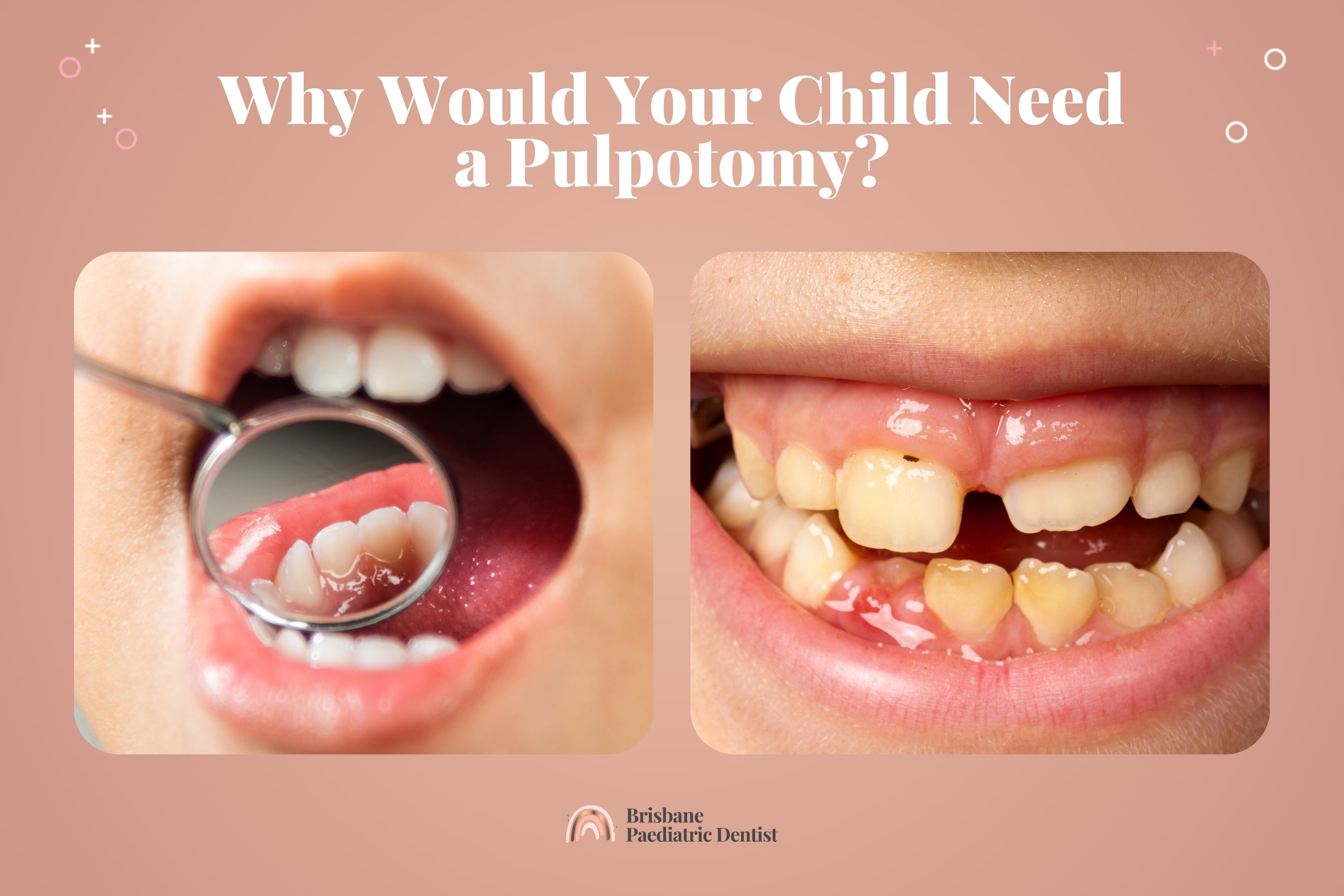
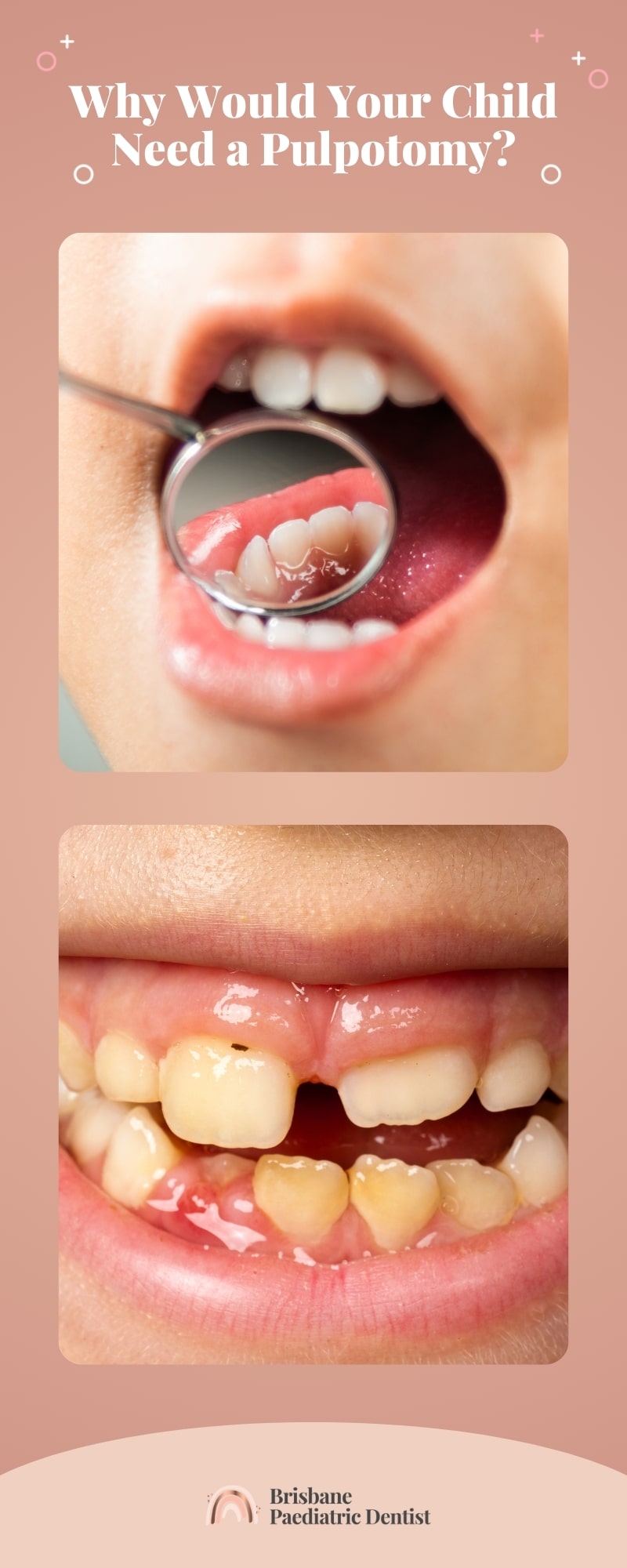
Sugary diets, poor oral hygiene, and developmental issues can all contribute to children’s tooth decay. If a cavity is left untreated, it can progress deep inside the tooth and reach the pulp inside, which contains nerves and blood vessels.
This leads to pulpitis (inflammation of the pulp), causing pain and potential infection. A pulpotomy is performed to alleviate the pain, eliminate the infection, and save the tooth from extraction.
Common Causes Requiring Pulpotomy
Tooth Decay
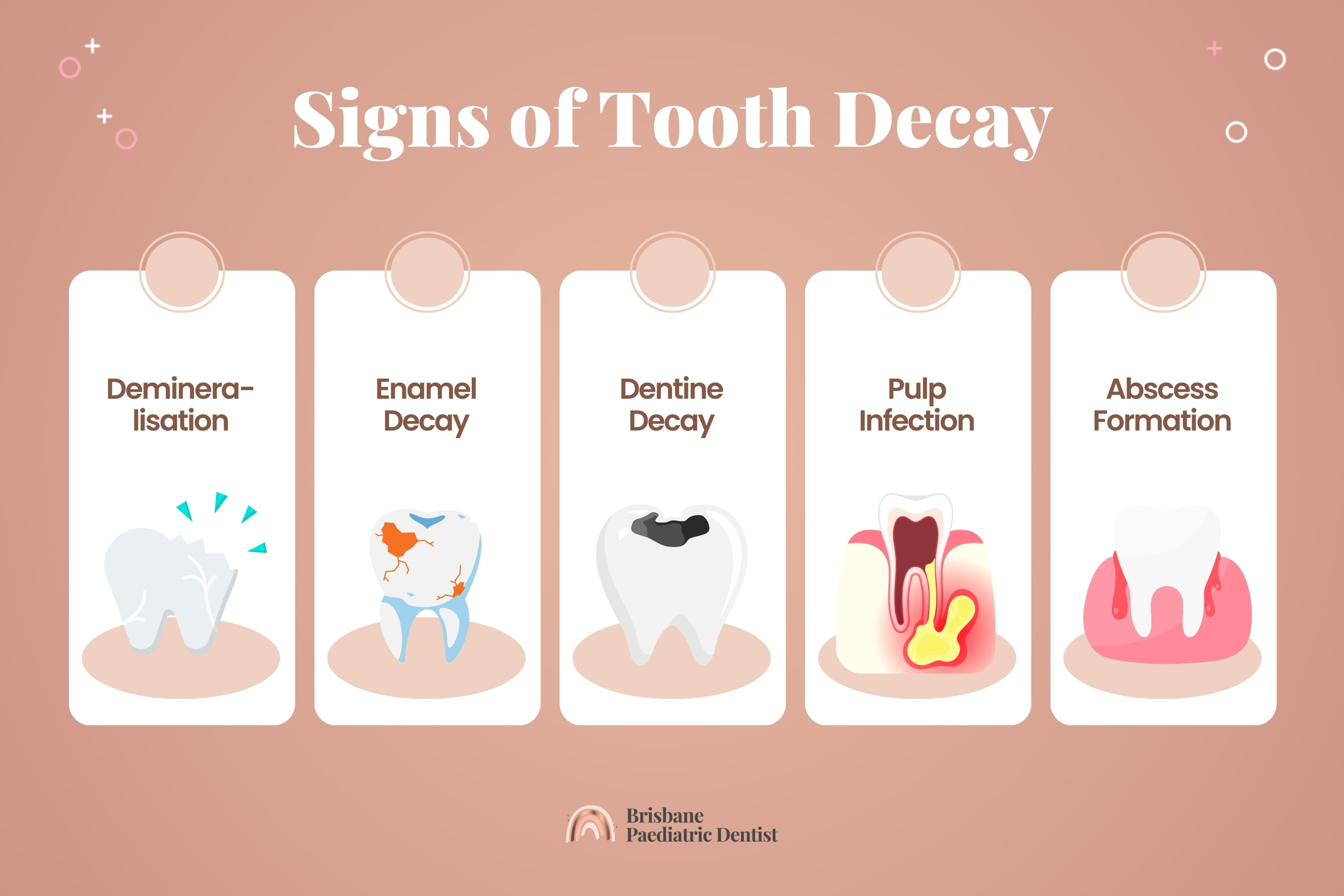

Tooth decay begins when plaque, a sticky film of bacteria, forms on teeth and produces acids that erode the enamel. If left untreated, this decay progresses deeper into the tooth, reaches the pulp and causes infection. This infection can lead to severe pain and swelling, making it necessary to remove the infected pulp to prevent further complications.
Stages of Tooth Decay
- Demineralisation: The outer layer of the tooth begins to break down due to acid exposure.
- Enamel Decay: Small cavities form as the enamel continues to erode.
- Dentine Decay: Decay reaches the dentine, creating increased sensitivity.
- Pulp Infection: The decay extends to the tooth’s pulp, causing infection and significant pain.
- Abscess Formation: If the infection in the pulp is not treated, it can spread to the surrounding tissues and form an abscess.
Tooth Injury
Tooth injuries are another common cause requiring a pulpotomy. Children are often prone to falls and accidents, especially during play or sports activities. These injuries can result in trauma to the teeth and lead to damage that may extend to the pulp.
Types of Tooth Injuries
- Fractured Tooth: A break in the tooth can expose the pulp, leading to infection if not treated promptly.
- Displaced Tooth: A tooth that has been pushed out of its normal position can cause damage to the pulp.
- Intruded Tooth: When a tooth is pushed into the jawbone, it can damage the pulp and surrounding tissue.
Prompt treatment of tooth injuries is important as it prevents further complications and can preserve the affected tooth.
Cracked or Chipped Tooth
When a tooth is cracked or chipped, the protective enamel is compromised, potentially exposing the dentine and pulp to bacteria and infection. If the crack or chip is significant enough to reach the pulp, a pulpotomy may be necessary to remove the infected tissue and restore the tooth’s health and function.
Signs of Pulp Infection in Children
Common signs of pulpitis in children include:
- Persistent toothache
- Sensitivity to hot and cold
- Swelling or redness in the gums around the affected tooth
- Difficulty chewing or biting
What are the Benefits of a Pulpotomy?
Preserving the Natural Tooth
A pulpotomy helps maintain your child’s natural tooth, which is significant for chewing, speaking, and holding space for adult teeth. By preserving the natural tooth, the procedure ensures that your child’s dental development is not disrupted, and they can continue to eat and speak normally.
Preventing the Spread of Infection
By removing the infected pulp and sealing the tooth, a pulpotomy prevents the spread of infection to surrounding teeth and tissue. This helps maintain overall oral health and prevents more severe dental issues that can result from untreated infections.
How Do I Prepare My Child for a Pulpotomy?
Before the procedure, discuss the pulpotomy with your child in simple terms. Explain that the paediatric dentist will help their tooth feel better and make it strong again. Reassure them that the procedure is safe and that they will be comfortable throughout.
The Pulpotomy Procedure: Step-by-Step
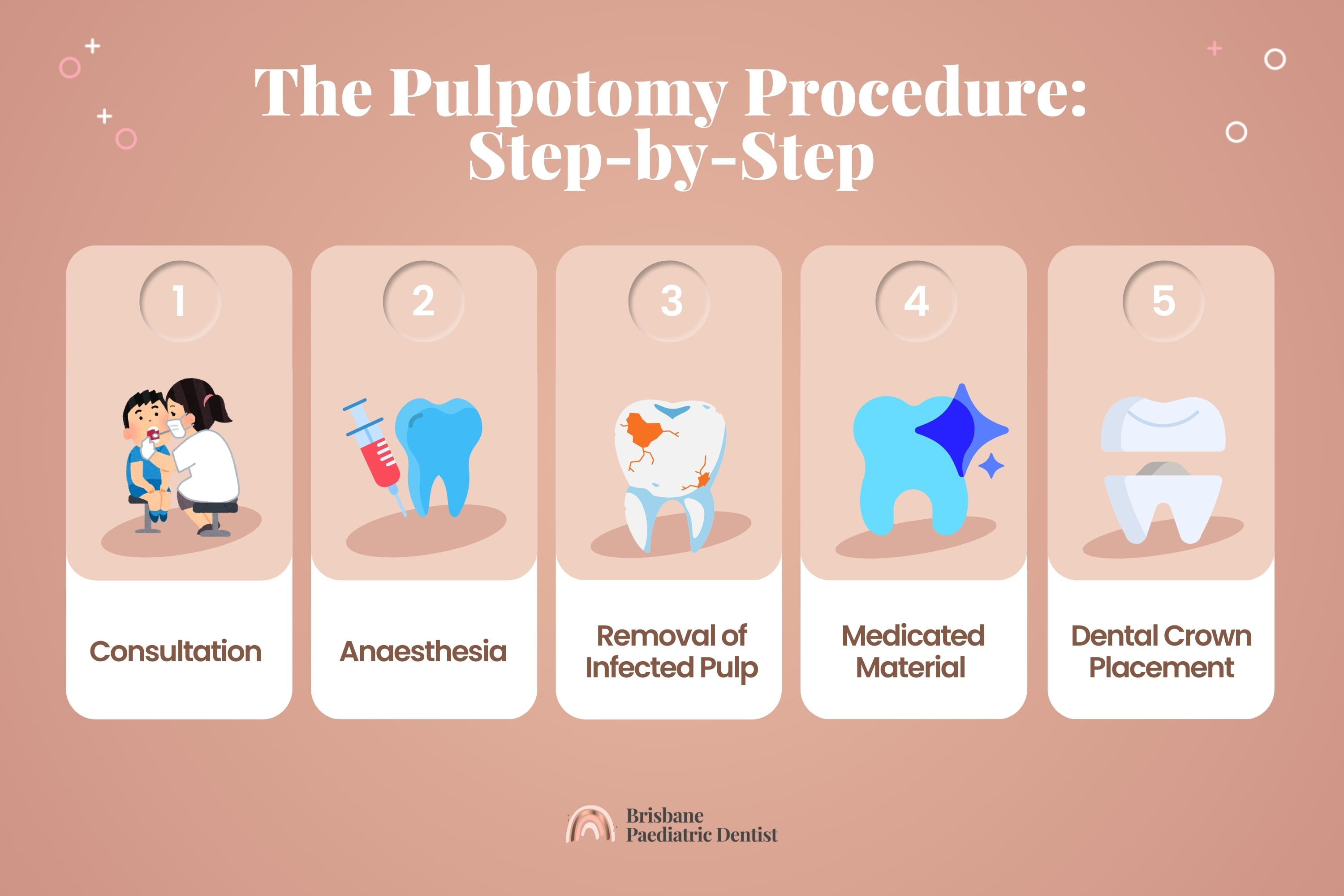
1. Consultation
The dentist may recommend a pulpotomy after examining your child’s tooth and taking X-rays to determine the extent of decay or damage.
2. Anaesthesia
The dentist administers a local anaesthetic to numb the area. For anxious children, options like nitrous oxide (laughing gas) may be discussed to help them relax.
3. Removal of Infected Pulp
The dentist creates an opening in the tooth and removes the infected pulp in the crown. This step eliminates the source of infection and prepares the tooth for further treatment.
4. Medicated Material
Medicated material is applied to disinfect and protect the remaining healthy pulp. The tooth is then filled with a biocompatible, dental cement that helps seal the tooth and prevent further infection.
5. Dental Crown Placement
A dental crown is placed to strengthen and protect the tooth, which is especially important for molars. The crown helps restore the tooth’s shape and function, so that it remains healthy and strong.
Post-Pulpotomy Procedure Care and Recovery
Managing Discomfort
Discomfort can usually be managed with over-the-counter pain relief, as recommended by your dentist. It is important to follow the dentist’s instructions regarding pain management and to contact the dentist if your child experiences severe pain or other complications.
Promoting Good Oral Hygiene Habits
Encourage regular brushing, flossing, and routine dental check-ups to maintain oral health. Good oral hygiene practices are essential to prevent further decay and maintain the health of the treated tooth.
Dietary Recommendations
Avoid sticky and sugary foods to prevent further tooth decay. Encourage your child to eat a balanced diet with plenty of fruit, vegetables, and dairy products that promote healthy teeth and gums.
Recovery Timeline
The recovery process typically takes a few days, during which your child should avoid hard or chewy foods that could damage the treated tooth. You should monitor your child’s recovery and ensure they follow the dentist’s recommendations for oral care and diet.
Is a Pulpotomy Painful?
With modern anaesthesia techniques, a pulpotomy isn’t painful. Your child may experience some mild discomfort after the anaesthesia wears off, but this can be managed with pain relievers.
How Long is a Pulpotomy Procedure?
A pulpotomy typically takes about 30 to 45 minutes to complete, though the exact time can vary based on the complexity of the case and the dentist’s approach. This relatively short time frame makes it a convenient option for treating severe tooth decay in children.
Is a Pulpotomy the Same as a Root Canal Treatment?
No, a pulpotomy is not the same as a root canal treatment. The difference between a pulpotomy and root canal is that a pulpotomy involves removing only the infected coronal pulp.
A root canal involves removing all the pulp from both the crown and the roots of the tooth. The canals are then cleaned, shaped, and filled with a biocompatible material to prevent future infection.
| Treatment | Pulpotomy | Root Canal Treatment |
|---|---|---|
| Area Treated | Crown only | Crown and roots |
| Invasiveness | Less invasive | More invasive |
| Typical Use | Primary (baby) teeth | Permanent teeth |
| Procedure Time | 30–45 minutes | 1–2 hours |
| Recovery Time | Shorter | Longer |
| Anaesthesia | Local, possibly sedation | Local, possibly sedation |
How are a Pulpotomy and Pulpectomy Different?
A pulpotomy removes the infected pulp from the crown of the tooth, whereas a pulpectomy involves removing all the pulp from both the crown and the roots. A pulpectomy is typically more invasive and is used when the infection has spread to the roots of the tooth.
Pulpotomy vs Tooth Extraction
In cases where the tooth’s pulp is severely infected and cannot be saved, the dentist will have to extract the tooth. A pulpotomy avoids this by removing the infected tooth pulp and preserving the remaining pulp.
Understanding the Pulpotomy Procedure FAQs
Can a Pulpotomy Be Performed on Permanent Teeth?
Is a Pulpotomy a filling?
Back to top: Understanding the Pulpotomy Procedure





